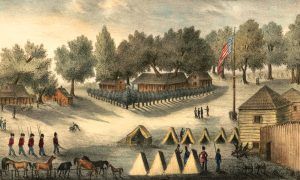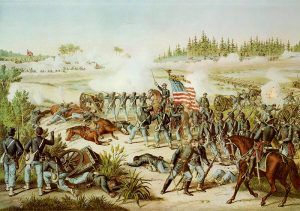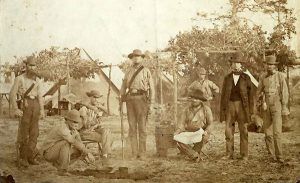
Confederate soldiers in Pensacola, Florida
Florida joined the Confederate States of America at the beginning of the Civil War, as the third of the original seven states to secede from the Union, following Abraham Lincoln’s 1860 election. With the smallest population, nearly half of them slaves, Florida could only send 15,000 troops to the Confederate States Army. Its chief importance was in food supply to the south, and support for blockade-runners, with its long coastline full of inlets, hard to patrol.
On the outbreak of war, the Confederates seized many of the state’s army camps, though the Union retained control of the main seaports. But there was little fighting in Florida, the only major conflict being the Battle of Olustee near Lake City in February 1864. However, wartime conditions made it easier for slaves to escape, and many of them became useful informers to Union commanders. As southern morale suffered, deserters from both sides took refuge in Florida, often attacking Confederate units and looting farms. Tallahassee became the second-last Confederate state capital to fall to the Union army.
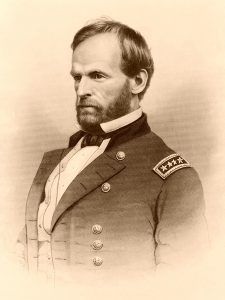
General William T. Sherman, John Chester, 1800s
In January 1865, Union General William T. Sherman issued special orders that set aside a portion of Florida as designated territory for runaway and freed former slaves who had accompanied his command during its March to the Sea. However, these controversial orders were not enforced in Florida and were later revoked by President Andrew Johnson.
When the war was over General Edward M. McCook’s Union division was assigned to re-establish Federal control and authority in Florida in early May 1865. Governor Milton committed suicide rather than submit to Union occupation. On May 13, Colonel George Washington Scott surrendered the last active Confederate troops in the state to McCook. On May 20th, General McCook read Lincoln’s Emancipation Proclamation during a ceremony in Tallahassee, officially ending slavery in Florida. That same day, his jubilant troopers raised the U.S. flag over the state capitol building. Tallahassee was the next to last Confederate state capital to fall to the Union army. Austin, Texas fell the next month.
Florida Civil War Battles:
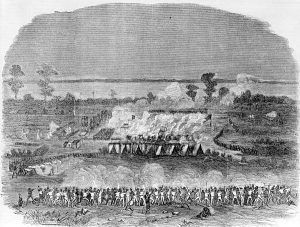
Battle of Santa Rosa Island, Florida in the Civil War
Santa Rosa Island – October 9, 1861 – This battle took place in Escambia County as part of the Operations of Gulf Blockading Squadron. After midnight on October 9, Brigadier General Richard Anderson crossed from the mainland to Santa Rosa Island with 1,200 men in two small steamers to surprise Union camps and capture Fort Pickens. He landed on the north beach about four miles east of Fort Pickens and divided his command into three columns. After proceeding about three miles, the Confederates surprised the 6th Regiment, New York Volunteers, in its camp and routed the regiment. General Anderson then adopted a defensive stance to entice the Federals to leave the fort and attack. Receiving reinforcements, Colonel Harvey Brown sallied against the Confederates, who re-embarked and returned to the mainland. The Union victory resulted in 67 Union casualties and 87 Confederate.
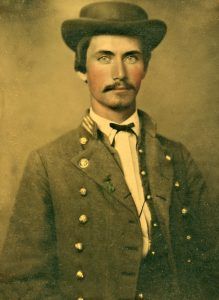
Confederate Captain
Tampa – June 30-July 1, 1862 -Also known as Yankee Outrage at Tampa, this skirmish occurred in the city of Tampa as part of the Operations against Tampa campaign. On June 30, 1862, a Union gunboat came into Tampa Bay, turned her broadside on the town, and opened her ports. The gunboat then dispatched a launch carrying 20 men and a lieutenant under a flag of truce demanding the surrender of Tampa. The Confederates refused, and the gunboat opened fire. The officer then informed the Confederates that shelling would commence at 6:00 pm after allowing time to evacuate non-combatants from the city. Firing continued sporadically into the afternoon of July 1, when the Federal gunboat withdrew. There were no casualties in this Confederate victory (Inconclusive, but Union gunboat withdrew.)
St. John’s Bluff – October 1-3, 1862 – This battle took place in Duval County as part of the Expedition to St. John’s Bluff. Brigadier General John Finegan established a battery on St. John’ s Bluff near Jacksonville to stop the movement of Federal ships up the St. Johns River. Brigadier General John M. Brannan embarked with about 1,500 infantry aboard the transports Boston, Ben DeFord, Cosmopolitan, and Neptune at Hilton Head, South Carolina, on September 30. The flotilla arrived at the mouth of the St. John’s River on October 1, where Cdr. Charles Steedman’s gunboats—Paul Jones, Cimarron, Uncas, Patroon, Hale, and Water Witch—joined them. By midday, the gunboats approached the bluff, while Brannan began landing troops at Mayport Mills. Another infantry force landed at Mount Pleasant Creek, about five miles in the rear of the Confederate battery, and began marching overland on the 2nd. Outmaneuvered, Lieutenant Colonel Charles F. Hopkins abandoned the position after dark. When the gunboats approached the bluff the next day, its guns were silent. The number of casualties in the Union victory are unknown.
Fort Brooke – October 16-18, 1863 – This skirmish took place in present-day Tampa, Florida as part of the Expedition to Hillsborough River. Two Union ships bombarded Fort Brooke on October 16 as a diversion, while a landing party under Acting Master T.R. Harris disembarked at Ballast Point and marched 14 miles to the Hillsborough River to capture several steamers. Harris and his men surprised and captured the blockade-running steamer Scottish Chief and sloop Kate Dale. The Rebels destroyed the steamer A.B. Noyes to preclude her capture. On its way back to the ship, Harris’ force was surprised by a detachment of the garrison, causing casualties. The Union victory resulted in an unknown number of casualties.
Olustee – February 20, 1864 – Also known as the Battle of Ocean Pond, this skirmish took place in Baker County as part of the Florida Expedition campaign. In February 1864, the commander of the Department of the South, Major General Quincy A. Gillmore, launched an expedition into Florida to secure Union enclaves, sever Rebel supply routes, and recruit black soldiers. Brigadier General Truman Seymour moved deep into the state, occupying, destroying, and liberating, meeting little resistance on February 20, he approached Brigadier General Joseph Finegan’s 5,000 Confederates entrenched near Olustee. One infantry brigade pushed out to meet Seymour’s advance units. The Union forces attacked but were repulsed. The battle raged, and as Finegan committed the last of his reserves, the Union line broke and began to retreat. Finegan did not exploit the retreat, allowing most of the fleeing Union forces to reach Jacksonville. The Confederate victory resulted in estimated casualties of 1860 Union and 946 Confederate.
Natural Bridge (March 6, 1865) – This battle took place in Leon County as part of the Operations near St. Marks Campaign. Major General John Newton had undertaken a joint force expedition to engage and destroy Confederate troops that had attacked at Cedar Keys and Fort Myers and were allegedly encamped somewhere around St. Marks. The Navy had trouble getting its ships up the St. Marks River. The Army force, however, had advanced and, after finding one bridge destroyed, started before dawn on March 6th to attempt to cross the river at Natural Bridge. The troops initially pushed Rebel forces back but not away from the bridge. Confederate forces, protected by breastworks, guarded all of the approaches and the bridge itself. The action at Natural Bridge lasted most of the day, but, unable to take the bridge, the Union troops retreated to the protection of the fleet. The Confederate victory resulted in an estimated 174 Union casualties and 26 Confederate.
Compiled and edited by Kathy Weiser-Alexander/Legends of America, updated June 2021.
Also See:
Sources:
National Park Service (broken link)
Wikipedia

